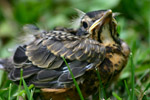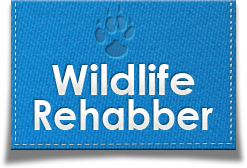It is critical to to determine if the baby is a good candidate for renesting, or if the baby should be taken to a wildlife rehabilitator for further care. Use the steps outlined in the table below as a guide.
Step 1: Screen for Illnesses/Injuries
|
- Is it injured? Any evidence of blood in any amount, any signs of torn or punctured skin, breathing heavily, sitting or laying in an awkward position, etc.
- Is it cold? A bird’s body temperature can range from 104-109 degrees. They should feel very warm to the touch.
- Does it’s abdomen appear overly wrinkled or paperish-white? Skin should be stretched tight and pink like the inside of your forearm.
- Does it’s abdomen and eyes appear sunken-in? They should have bright round eyes and enormous pot-bellies.
- Is it lethargic, inactive, keeps its eyes closed most of the time, prefers to keep its head tucked back into its feathers, or uninterested in it’s surroundings?
- Was it handled by a dog or cat/did you find it near a dog or cat?
- Is it in imminent danger (from children, pets, predators, traffic)?
- Are there dead siblings/parents near-by?
- Are there flies or ants around the baby?
- Does the baby seem extra fluffy or “puffy”?
- Possible fractures? When you gently extend wings and legs, the baby should be able to easily pull them back into proper position.
|
If you answered “yes” to any of these questions, skip to Step 3 for information on what to do with this baby until you can locate a rehabilitator and transport the baby.
If “no” continue to Step 1.a.
|
Step 1.a
Do you suspect that this baby fell from your dryer/kitchen/bathroom vent, eaves of your roof, attic, or any other area inside of or close to your house?
|
If “yes” Click Here. If “no” continue to Step 2 below. |
Step 2: Determine Age
|
| It is important to age the baby to determine whether it is suitable for renesting. A baby could be too young and too fragile to survive the renesting process, or even too old to “cooperate” during a reunite attempt. |
 |
Hatchlings
- This refers to baby birds usually less than 14 days old that are naked or have minimal feather development.
- These birds quickly lose body temperature and require feedings every 15-30 minutes.
- They require specialized care and should be immediately taken to a wildlife rehabilitator.
|
Jump to Step 3. |
|

4 weeks old
|
Nestlings
Baby birds that are under 2-4 weeks of age and feathering or are almost fully feathered.
Their parents feed them every 30-45 minutes.
They may, or may not have exposed areas of skin on their back or bellies, or have a little fuzzy tufts of down sticking out from their feathers.
They have no tail feathers yet, or their tail feathers are less than half inch long.
If they fall out of their nest (due to overcrowding, weather or predators) they may move around a little on the ground, maybe even hop a few steps, but prefer to sit in one spot.
They are usually not very far away from their nest.
|
Skip to Step 4. |
 |
Fledglings
- Birds that are 5-7 weeks old and are fully feathered and very mobile.
- Their tail feathers are usually 3/4 inch long or longer but not quite as long as an adult’s tail feathers.
- At this stage, they have begun perching on the edge of their nest and hopping around branches in the trees.
- They are being fed every hour to hour and a half.
- They are not yet capable of flying or only partially flighted, because they still have their “baby fat” and their wing feathers aren’t long enough yet.
- They can use low branches to hop back up into a tree if they fall or jump down to follow their parents. Unfortunately, they are grounded if there are no low lying branches to use for hopping but up the tree.
- They are not good candidates for renesting because they are the equivalent of a two-year old child and just won’t “stay put” if placed in the original or a substitute nest.
- They have a bad habit of wandering off, and getting separated from their parents.
- They require an alternative method to attempt to reunite them with their parents.
- They are very alert and active, are extremely difficult to catch, and are very vocal when caught.
|
If your fledgling is not a bouncing ball of energy, and was fairly easy to catch go to Step 3;
otherwise ==> Skip to Step 5.
|
 |
Juveniles
- Young birds that are 7-9 weeks old and are fully feathered and very mobile.
- They may look exactly like an adult bird.
- At this stage they are skilled flyers, are following their parents around for food and even practice foraging for food.
- But they are not skilled enough to completely feed themselves and are being fed every 1 1/2 to two hours.
- They still have a hint of gape flanges (the flexible white or yellow skin at the corners of their mouth) that allows them to open their beaks really wide when their parents feed them.
- They are very alert and active, are extremely difficult to catch, and are very vocal when caught.
- If you can catch a juvenile songbird, it should be examined by a wildlife rehabilitator because most likely something is wrong.
|
Go to Step 3 |
|





